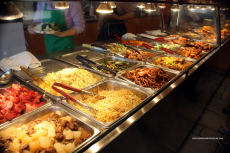
Like the country itself, Chinese food comes from thousands upon thousands of years of civilisation in East Asia. However, Chinese food doesn’t just come from the whole country – different regions have different styles of cooking, for instance Szechuan cooking (including Kung Pao Chicken) is very different from Cantonese cooking, which is the style of Chinese cooking people in the West recognise as representative of the entire country’s food. The regional styles of cooking differ immensely in China, partly because the country itself is so huge. The history of Chinese food is a long one, too! So buckle up, try not to get hungry, and enjoy the ride.
Many staples of Chinese cuisine, like rice and noodles, have been present since the Han dynasty – which took place concurrently with the Roman era in Europe. This was also true of soy sauce, a sauce we tend to perceive as one of the most important for Chinese cooking.
Another Chinese ruling dynasty that had a significant impact upon food was the Tang dynasty. Many foods from West Asia were brought over to China – foods like apples, pomegranates, garlic and pears. As the Tang trade throughout Asia, peaches, figs, dates, mangoes and sugar cane came to be incorporated into Chinese cooking.
Tea was popularised in China about 500AD. As it would be in Britain a thousand years later, tea was the drink of the wealthy and sophisticated. Some thought it had medicinal properties. It was brought over to Europe, not by the British, but by the Portuguese. The wife of King Charles the II, Catherine of Braganza, was Portuguese and she is credited with popularising the drink in Britain. The Tang Dynasty was the period in which tea was introduced to other parts of Asia, including Japan and Korea.
The Tang dynasty also helped to develop methods of food preservation. Europeans used salt, and so did ordinary Chinese folk. The Tang dynasty also promoted the use of ice to preserve food, but this only really expanded as far as the wealthy. Labourers sent by the Emperor had to cut a thousand huge blocks of ice blocks from frozen water in the mountains, and this was backbreaking work. The days before fridges were invented were a real struggle for many people!
The Song dynasty was the next dynasty to make big changes to Chinese food. It began to look similar to the Chinese food we would recognise today. Sesame oil and olives came to China, but so did restaurants – establishments where customers could choose what they wanted to eat from a menu. Previously, people had paid for a meal and got what they were given, so they had no choice.
Potentially the most famous dynasty, the Ming dynasty existed from 1368-1644, and trade with Europe and the New World greatly diversified the Chinese food market. One introduction included the sweet potato, which became the crop of the poor, much like potatoes were the crop of the poor in Ireland.
Since China became Communist in 1949, there have been many problems with grain. Early in the period, almost 40% of grain was handed over to the government, which caused a widespread famine. However, since the 1990s the food situation has been improving, and even Chinese Islamic food has benefitted.
We might know Chinese food from those delicious takeaways in our towns, cities and villages, but it’s important to remember how Chinese food is so much more than just fried rice and dim sum.
Image from: http://girlwhowouldbeking.com/2014/02/03/simply-satisfying-a-chinese-dinner-you-can-do/

0 Comment:
Be the first one to comment on this article.